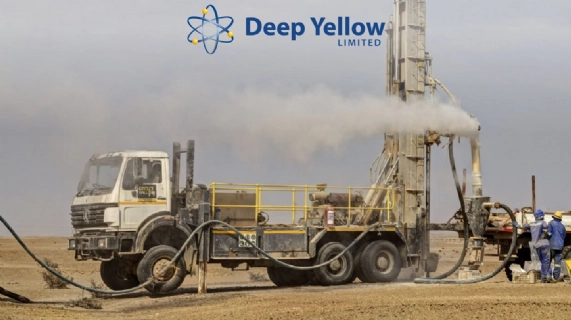
Drilling Identifies New Region of High Uranium Interest
Perth, Nov 5, 2018 AEST (ABN Newswire) - Deep Yellow Limited ( ASX:DYL) (
ASX:DYL) ( DYLLF:OTCMKTS) is pleased to announce that the current phase of broad delineation drilling in the Tumas 1 East area on EPL3497 has now been completed. Extensive uranium mineralisation has been identified in the Tumas 1 East palaeochannel area within a system of newly defined Tributaries 1, 2, 4 and 5. Resource infill drilling will now start in Tributary 1. EPL3497 is held by Reptile Uranium Namibia (Pty) Ltd (RUN), part of the group of companies wholly owned by Deep Yellow.
DYLLF:OTCMKTS) is pleased to announce that the current phase of broad delineation drilling in the Tumas 1 East area on EPL3497 has now been completed. Extensive uranium mineralisation has been identified in the Tumas 1 East palaeochannel area within a system of newly defined Tributaries 1, 2, 4 and 5. Resource infill drilling will now start in Tributary 1. EPL3497 is held by Reptile Uranium Namibia (Pty) Ltd (RUN), part of the group of companies wholly owned by Deep Yellow.
HIGHLIGHTS
- Completion of current phase of first pass delineation drilling has opened a multiple mineralised channel system ready for detailed resource drilling follow-up
- Highly significant uranium mineralisation confirmed in previously unknown Tumas 1 East tributary channels 1, 2, 4 and 5
o 16km of mineralised channel identified for follow-up resource drilling
- With 35 holes for 419m completed since last release, 50% of the holes returned >100ppm eU3O8 over 1m - best intersections
o TA145 3m at 306ppm eU3O8 from 5m
o TA154 5m at 430ppm eU3O8 from surface
o TA170 9m at 221ppm eU3O8 from 7m
- Resource upgrade drilling commenced 2 November on Tributary 1 and will commence on 5 November on Tumas 3 West
- Mineralisation is calcrete-associated hosted within palaeochannels, similar to the Langer Heinrich uranium mine located 30km to the north
Since the last drilling update (as reported 17 October 2018) 35 holes have been drilled for 419m between 12 October to 1 November, completing the current phase of the target delineation work in this area. In total 180 RC holes have been drilled in the Tumas 1 East area for 2,173m to broadly test the tributary channels for mineralisation with positive results being returned.
Further work will now shift to resource drilling in this area until the end of 2018. A second RC drill rig has also been contracted to begin resource drilling on 5 November over the highly prospective western extension of the Tumas 3 discovery. Figure 1 shows the prospective paleochannel system outline and prospect locations.
Tumas 1 East Drilling
Broad exploration delineation drilling testing the headwaters east of the Tumas 1 deposit has identified a multipronged channel system comprising, at this stage, 7 tributaries draining into the main Tumas palaeochannel as shown in Figure 2.
The 35 holes drilled since 12 October have continued to indicate promising mineralisation, this time in the eastern portion of Tributary 2 (see Figure 3) and in the previously untested Tributary 5 area where a wide mineralised channel has been identified (see Figure 4). This work has considerably expanded the area of high significance for uranium mineralisation. With this work, the drilling has identified a total of 15-16km highly prospective channels available for resource upgrade work. Large portions of Tributary 4 and 5 still remain to be tested to the west of where currently drilled. The interpreted Tributary 6 remains untested.
These new results produced intersections in the range of 143ppm U3O8 over 10m (TA165) to 430ppm U3O8 over 5m (TA154). The average thickness of the mineralisation is close to 5m.
Drill hole and channel locations are shown in Figure 2. Figures 3 and 4 show drill crosssections through Tributaries 2 and 5 respectively, highlighting the continuity and thickness of mineralisation.
Mineralised intersections from the current reporting period that are above the 100ppm U3O8 over 1m cut-off are tabulated in Table 1, Appendix 1. Table 2 in Appendix 1 lists all drill holes from this reporting period. The equivalent uranium values are based on down-hole radiometric gamma logging carried out by a fully calibrated Aus-Log gamma logging system.
In summary, with completion of the current phase of the target delineation work carried out in September and October, the following can now be stated:
- The main Tributary 1 target shows continuous calcrete-type uranium mineralisation along 4.6km length. This channel ranges from 100m to 900m in width. The mineralisation is located at shallow depth from surface to 12m below surface. Except for localised hot spots, large parts of this mineralisation do not show any surface radiometric expression.
- Tributaries 2 and 3 are less mineralised except for the eastern headwaters of Tributary 2 showing encouraging results along 2km of channel way.
- Both Tributaries 4 and 5 north of Tributary 1 show encouraging results indicating possible uranium mineralisation along a further 10km of channel length.
- Tributary 6 is currently defined from air photo interpretation and geological mapping only and remains to be tested.
Analysis/Conclusion
To date a total of 180 holes for 2,173m were drilled in the area. Drill spacings have varied from 50m to 100m along lines 200m to 1,600m apart. 103 of these holes returned positive results of more than 100ppm eU3O8 over 1m. This reflects an almost 60% success rate. The average grade of the 1m intersections >100ppm U3O8 is 295ppm and >200ppm U3O8 is 433ppm which is the cut-off used in the previous resource estimates.
The results of the ongoing exploration are regarded as very encouraging. This drilling in what was a previously unknown headwater system of the Tumas palaeochannel system has identified a new continuous calcrete type uranium mineralisation at shallow depth. Importantly, new uranium mineralisation in the tributary paleochannel system in the Tumas East area has opened up the potential for further mineralisation in Tributaries 2, 4, 5 and possibly 6, along an extensive strike length.
The ongoing work continues to show that the uranium mineralisation is not confined to one simple, single channel but rather is associated with a complex palaeodrainage system containing several channels and tributaries.
This fourth (ongoing) drilling campaign is continuing to produce positive results. This is not only expected to add to the current uranium resource base of this project but, just as significantly, continues to emphasise the strong exploration potential of the extensive, uranium-fertile palaeochannel system within which the new Tumas palaeochannel discoveries occur.
The drill program emphasis will now change to resource drilling at Tumas 1 East and Tumas 3 West. A second RC drilling rig has been contracted to start the resource drilling at Tumas 3 West. These drilling programs will continue into December.
An updated Inferred Resource estimation for the Tumas 1 East Zone, in conjunction with Tumas 1 & 2 and Tumas 3 West is expected to be delivered in early 2019.
CEO Comment
John Borshoff commented: "Our work on the Reptile Project is again confirming the very high prospectivity of the Tumas palaeochannel system that has been identified. The new zone of mineralisation that has been discovered to the east adds significantly to the potential of these channels, which are showing all the hallmarks of being able to substantially increase the currently identified resource base associated with this regionally extensive target."
To view tables and figures, please visit:
http://abnnewswire.net/lnk/4QBBTS68
About Deep Yellow Limited
 Deep Yellow Limited (ASX:DYL) (OTCMKTS:DYLLF) is successfully progressing a dual-pillar growth strategy to establish a globally diversified, leading uranium company producing 10+ Mlb pa. The Company's portfolio consists of two advanced projects in Tier-1 uranium mining jurisdictions - flagship Tumas in Namibia and Mulga Rock, Western Australia.
Deep Yellow Limited (ASX:DYL) (OTCMKTS:DYLLF) is successfully progressing a dual-pillar growth strategy to establish a globally diversified, leading uranium company producing 10+ Mlb pa. The Company's portfolio consists of two advanced projects in Tier-1 uranium mining jurisdictions - flagship Tumas in Namibia and Mulga Rock, Western Australia.
Deep Yellow's future growth is underpinned by its highly prospective exploration portfolio - Alligator River, Northern Territory and Omahola, Namibia with ongoing M&A focused on high quality assets should opportunities arise that best fit the Company's strategy. Led by a best-in-class team, who are proven uranium mine builders and operators, the Company is advancing its growth strategy at a time when the need for nuclear energy is becoming the only viable option in the mid-to-long-term to provide baseload power supply and achieve zero emission targets. Importantly, Deep Yellow is on track to becoming a reliable and long-term uranium producer, able to provide production optionality, security of supply and geographic diversity.
| ||
|









